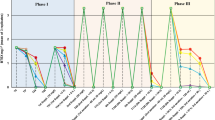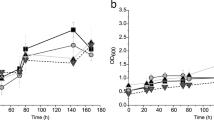Abstract
Enrichment-based methods targeted at uranium-tolerant populations among the culturable, aerobic, chemo-heterotrophic bacteria from the subsurface soils of Domiasiat (India’s largest sandstone-type uranium deposits, containing an average ore grade of 0.1 % U3O8), indicated a wide occurrence of Serratia marcescens. Five representative S. marcescens isolates were characterized by a polyphasic taxonomic approach. The phylogenetic analyses of 16S rRNA gene sequences showed their relatedness to S. marcescens ATCC 13880 (≥99.4% similarity). Biochemical characteristics and random amplified polymorphic DNA profiles revealed significant differences among the representative isolates and the type strain as well. The minimum inhibitory concentration for uranium U(VI) exhibited by these natural isolates was found to range from 3.5–4.0 mM. On evaluation for their uranyl adsorption properties, it was found that all these isolates were able to remove nearly 90–92% (21–22 mg/L) and 60–70% (285–335 mg/L) of U(VI) on being challenged with 100 μM (23.8 mg/L) and 2 mM (476 mg/L) uranyl nitrate solutions, respectively, at pH 3.5 within 10 min of exposure. his capacity was retained by the isolates even after 24 h of incubation. Viability tests confirmed the tolerance of these isolates to toxic concentrations of soluble uranium U(VI) at pH 3.5. This is among the first studies to report uranium-tolerant aerobic chemoheterotrophs obtained from the pristine uranium ore-bearing site of Domiasiat.
Similar content being viewed by others
References
Acharya, C., D. Joseph, and S.K. Apte. 2009. Uranium sequestration by a marine cyanobacterium, Synechococcus elongatus strain BDU/75042. Bioresour. Technol. 100, 2176–2181.
Altschul, S.F., T.L. Madden, A.A. Schaeffer, J. Zhang, Z. Zhang, W. Miller, and D.J. Lipman. 1997. Gapped BLAST and PSI-BLAST: a new generation of protein database search programs. Nucleic Acids Res. 25, 3389–3402.
Angle, J.S., R.L. Chaney, and D. Rhee. 1993. Bacterial resistance to heavy metals related to extractable and total metal concentrations in soil and media. Soil Biol. Biochem. 25, 1465–1466.
Barkay, T. and J. Schaefer. 2001. Metal and radionuclide bioremediation: issues, considerations and potentials. Curr. Opin. Microbiol. 4, 318–323.
Choudhary, S. and P. Sar. 2009. Characterization of a metal resistant Pseudomonas sp. isolated from uranium mine for its potential in heavy metal (Ni2+, Co2+, Cu2+ and Cd2+) sequestration. Bioresour. Technol. 100, 2482–2492.
Chun, J., J-H. Lee, Y. Jung, M. Kim, S. Kim, B.K. Kim, and Y.W. Lim. 2007. EzTaxon: a web-based tool for the identification of prokaryotes based on 16S ribosomal RNA gene sequences. Int. J. Syst. Evol. Microbiol. 57, 2259–2261.
Davis, L.G., M.D. Dibner, and J.F. Battey. 1986. Basic methods in molecular biology, pp. 42–43. Elsevier Sci Publ, 3rd ed. New York, NY, USA.
Fortin, C., F.H. Denison, and J. Garnier-Laplace. 2007. Metal phytoplankton interactions: Modelling the effect of competing ions (H+, Ca2+, and Mg2+) on uranium uptake. Environ. Toxicol. Chem. 26, 242–248.
Francis, A.J., J.B. Gillow, C.J. Dodge, R. Harris, T.J. Beveridge, and H.W. Papenguth. 2004. Uranium association with halophilic and non-halophilic bacteria and archaea. Radiochim. Acta. 92, 481–488.
Grimont, F. and P.A. Grimont. 1992. The Genus Serratia, pp. 2822–2848. In A. Balows, H.G. Trusper, M. Dworkin, W. Harder, and K.H. Schleifer (eds.), The Prokaryotes. 2nd ed. vol. 3. Springer-Verlag, New York, NY, USA.
Haferburg, G. and E. Kothe. 2007. Microbes and metals: interactions in the environment. J. Basic Microbiol. 47, 453–467.
Koch, A.L. 1981. Growth measurement, pp. 179–207. In P. Gerhaldt, R.G.E. Murray, R.N. Costilow, E.W. Nestar, W.A. Wood, N.R. Krieg, and G.B. Phillips (eds.), Manual of methods for general bacteriology. American Society of Microbiology, Washington, DC, USA.
Martinez, R.J., Y. Wang, M.A. Raimondo, J.M. Coombs, T. Barkay, and P.A. Sobecky. 2006. Horizontal gene transfer of PIB-type ATPases among bacteria isolated from radionuclide- and metal-contaminated subsurface soils. Appl. Environ. Microbiol. 72, 3111–3118.
Nies, D.H. 1999. Microbial heavy-metal resistance. Appl. Microbiol. Biotechnol. 51, 730–750.
Ohnuki, T., T. Yoshida, T. Ozaki, M. Samadfam, N. Kozai, K. Yubuta, T. Mitsugashira, T. Kasama, and A.J. Francis. 2005. Interactions of uranium with bacteria and kaolinite clay. Chem. Geol. 220, 237–243.
Pollmann, K., J. Raff, M. Merroun, K. Fahmy, and S. Selenska-Pobell. 2006. Metal binding by bacteria from uranium mining waste piles and its technological applications. Biotechnol. Adv. 24, 58–68.
Raju, D., R.P. Selvam, and S.N. Virnave. 1989. Characterisation of the upper cretaceous lower mahadek sandstone and its uranium mineralisation in the Domiasiat-Gomaghat Pdengshakap area, Meghalaya, India. Expl. Res. Atom Minerals 2, 1–27.
Ramana, M.V., D.G. Thomas, and S. Varughese. 2001. Estimating nuclear waste production in India. Curr. Sci. 81, 1458–1462.
Roane, T.M. and S.T. Kellogg. 1996. Characterization of bacterial communities in heavy metal contaminated soils. Can. J. Microbiol. 42, 593–603.
Rohlf, F.J. 1990. NTSYS-pc. Numerical taxonomy and multivariate analysis system, version 2.0. Exeter software, New York, NY, USA.
Ruggiero, C.E., H. Boukhalfa., J.H. Forsythe, J.G. Lack, L.E. Hersman, and M.P. Neu. 2005. Actinide and metal toxicity to prospective bioremediation bacteria. Environ. Microbiol. 7, 88–97.
Savvin, S.B. 1961. Analytical use of arsenazo III: determination of thorium, zirconium, uranium and rare earth elements. Talanta. 8, 673–685.
Schmidt, A., G. Haferburg, M. Sineriz, D. Merten, G. Buchel, and E. Kothe. 2005. Heavy metal resistance mechanisms in actinobacteria for survival in AMD contaminated soils. Chem. Erde. Geo. Chem. 65, 131–144.
Sengupta, B., R. Bahuguna, S. Kumar, R. Singh, and R. Kaul. 1991. Discovery of a sandstone-type uranium deposit at Domiasiat, West Khasi hills district, Meghalaya, India. Curr. Sci. 61, 46–47.
Sneath, P.H.A. and R.R. Sokal. 1973. Numerical taxonomy: the principles and practice of numerical classification. W. H. Freeman, San Francisco, USA.
Suzuki, Y. and J.F. Banfield. 2004. Resistance to, and accumulation of, uranium by bacteria from a uranium contaminated site. Geomicrobiol. J. 21, 113–121.
Tamura, K., J. Dudley, M. Nei, and S. Kumar. 2007. MEGA4: molecular evolutionary genetics analysis (MEGA) software version 4.0. Mol. Biol. Evol. 24, 1596–1599. 〈10.1093/molbev/msm092〉.
Yilmaz, E.I. 2003. Metal tolerance and biosorption capacity of Bacillus circulans strain EB1. Res. Microbiol. 154, 409–415.
Author information
Authors and Affiliations
Corresponding author
Rights and permissions
About this article
Cite this article
Kumar, R., Acharya, C. & Joshi, S.R. Isolation and analyses of uranium tolerant Serratia marcescens strains and their utilization for aerobic uranium U(VI) bioadsorption. J Microbiol. 49, 568–574 (2011). https://doi.org/10.1007/s12275-011-0366-0
Received:
Accepted:
Published:
Issue Date:
DOI: https://doi.org/10.1007/s12275-011-0366-0




